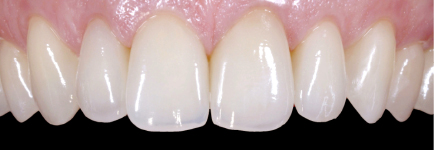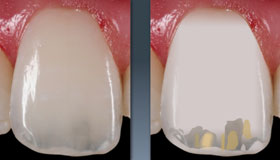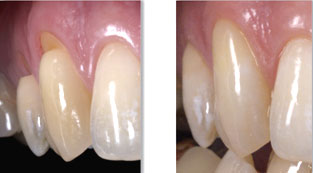- Deutsch|
- English

 Bonding/Veneers have been attached to each tooth
Bonding/Veneers have been attached to each tooth
Aesthetics / Veneers / Composite
(Beautiful teeth, aesthetic frontal teeth restoration and correction in Frankfurt)
Aesthetics (from the ancient Greek αἴσθησις aísthēsis, “perception”, “sensation”) was until the 19th century a doctrine about perceptible beauty, and of regularity and harmony in nature and art. Colloquially aesthetic often just means beautiful, tasteful or attractive.
Aesthetics in dentistry now means treating teeth to make them look natural and attractive, in particular by correcting their alignment or discolouration. Aesthetics results in a naturally attractive smile.
The focus of my current work is the aesthetic restoration of the incisors and posterior teeth. Teeth are treated by carefully observing their formation and intended function. Restoring a tooth to ensure it can continue to chew food means applying appropriate biometrical criteria; a “false tooth” should integrate with its surrounding physiology and not stand out.
 One way of preparing for a veneer: The enamel is slightly reduced.
One way of preparing for a veneer: The enamel is slightly reduced.
Aesthetics / Veneers / Composite
(Fully ceramic partial crowns, Veneers, Laminates, minimally-invasive and non-invasive treatment)
Veneers are ceramic or formed from a synthetic composite and are fixed to teeth with an adhesive in order to correct discoloured or worn-down teeth, and were used in Hollywood over 50 years ago. Veneers provided Marilyn Monroe for example with her perfect smile.
Modern dentistry often uses Veneers as a standard way of treating teeth with a minimum of fuss and preparation, thus protecting the remaining part of the tooth. Veneers can also replace tooth mass that may have been lost through Bulimia, restoring the original appearance.
In difficult cases – for example a misaligned bite, or a lack of ability to bite (as well as severe aesthetic cases) it is necessary to prepare the tooth to provide something stable onto which a full-ceramic partial crown can be placed.
 The aesthetic correction of upper incisors and canine teeth enabled by the application of veneers. This correction of the teeth of an older patient was possible without orthodontic surgery
The aesthetic correction of upper incisors and canine teeth enabled by the application of veneers. This correction of the teeth of an older patient was possible without orthodontic surgery
 Gaps closed by means of veneers
Gaps closed by means of veneers
Aesthetics / Veneers / Composite
(Composite fillings – i.e., synthetic fillings and composite veneers, flow)
Composite is a tooth-coloured filling material and is composed of both organic and inorganic material. Composite was originally used almost exclusively to fill front teeth, but is now successfully applied to the other teeth. Further development of bonding material has improved and extended our ability to adhere composites permanently.
Composites were classically used to repair teeth attacked by caries, filling the cavities with material that exactly matched the colour of the tooth. Modern composites enable the formation of the individual layers of a tooth. An ability to recognise and manage colour variation is absolutely essential to a perfect outcome.
High stability enables gaps to be closed between the front teeth (Diastema), and if a front tooth has been broken it is possible to reconstruct the entire tooth, or even stick the broken part back on providing it has not been too badly damaged.

The colour of a natural tooth provides the dentist with a plan which can be used in the recreation of a damaged tooth.

Then the natural reconstruction of an incisor broken after an accident follows a colour analysis and the preparation of a layering template. The colour of the tooth next to the damaged one was used as the exemplar to ensure the damaged tooth retained a natural appearance.
A composite veneer can also be used to restore teeth that require repositioning or realigning. [See also Publications] The material can be layered in different colours.

Correctly aligning teeth can be achieved through composites, which results in a completely changed appearance. A direct composite veneer (applied non-invasively) can be integrated perfectly into its orthodontic surroundings. The misalignment becomes invisible.

Flow is a malleable/flowable material which has very similar properties to the more conventional and firmer composites. It is eminently suitable for the correction of small defects, particularly wedge-shaped defects at the gingival margin. Its flexibility allows the dentist to apply it with great precision, allowing the original tooth to be restored exactly. This also helps protects teeth from acid and bacteria.

Typical Wedge-shaped defects that have been treated using Flow, enabling a morphological reconstruction of the original shape of the tooth.

